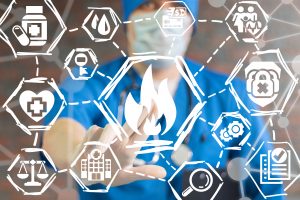September 2021
Inside This Issue
Sentinel Event Statistics:
If you are pressed for time, there are no new standards requirements announced this month from either TJC or CMS. The lead article in Perspectives very briefly discusses their first half year 2021 sentinel event statistics. We noted that in the first half year there have been a total of 569 self-reported and otherwise identified sentinel events that the Joint Commission has become aware of.
This contrasts with the entire year 2020, when 809 total sentinel events were identified. There are no additional details about the types of events, this year’s root causes, or a theory as to why the rate of 2021 reporting seems higher in the Perspectives article. We did go and look at the Joint Commission’s website for additional details on the 2021 data, but these are not posted at this point in time.
Diverse Populations:
 Perspectives also contains a discussion about the Joint Commission’s recently published Quick Safety #60 posted in July describing the need to better understand the needs of diverse populations.
Perspectives also contains a discussion about the Joint Commission’s recently published Quick Safety #60 posted in July describing the need to better understand the needs of diverse populations.
The Quick Safety describes a CMS “Accountable Health Communities” model that suggests providers screen for the needs of the population in five additional domains. These are:
- Housing instability
- Difficulty in paying utility bills
- Food insecurity
- Transportation problems
- Interpersonal violence
There is also a link within the Quick Safety to the CMS AHC findings at a glance and the evaluation of performance during the period from 2017 to 2020.
Home Care SAG Error:
Home care program readers should note that Perspectives announced that the CAMHC Standards Applicability Grid (SAG) published in the Spring 2021 update contains an important error. The publication identified that standard EM.03.01.03 was only applicable in the home health and hospice program segments.
In actuality, this standard is applicable in all program segments including personal care/support, DME, orthotics/prosthetics, clinical respiratory services, rehabilitation technology, and pharmacy. We suggest editing your SAG and sharing the standard and its elements of performance with service line managers for these services.
Draft Standards Field Review:
The last page of Perspectives discusses the two field reviews we mentioned last month and both are now open for review and comments. The first one is proposed changes to the existing antibiotic stewardship standards and this field review ends September 15th. The second was just posted and contains proposed changes to the emergency management standards and this field review will be open until October 29th.
These are both important opportunities to review and comment on proposed standards. In particular, given the experience of the last two years with emergency management planning and operations, it is likely all readers have some ideas on how to better manage through emergencies and disasters. TJC has posted a comments link in addition to the draft standards.
Building Fire Protection: 
This month’s Consistent Interpretation column discusses LS.02.01.10, EPs 1, 7, and 9. EP 1 requires the organization to meet the construction requirements for its height and type. One important issue that gets scored against this EP is when fireproofing material is missing from structural steel. If this condition exists then the structural steel will be compromised. In theory if your building has passed its opening certification, fire marshal inspections and previous Joint Commission surveys, you would assume that the structural steel is appropriately fire proofed, but strangely we sometimes find and Joint Commission sometimes finds structural steel that was never fire proofed, or fire proofing has deteriorated.
Guidance is also provided for EP 7 which establishes requirements for fire walls. The issue that is sometimes, but not often noted is when the fire wall has a gap in it where the wall does not extend completely from the floor deck to the deck above. You might think this is not possible, but this defect is sometimes hidden, above the suspended ceiling. This issue, plus the more frequently occurring cables resting on a sprinkler pipe, or open electrical junction boxes, all speak to the need for a good above the ceiling inspection process. When surveyors sample areas, their above the ceiling process does frequently find the fire wall compromised or other infraction.
Lastly, they discuss EP 9, a much more frequently cited issue where labels on a fire door are either missing or painted over. The door may look solid and latch like a fire door should, but if the label isn’t readable, or its missing, it’s not going to pass inspection. There are requirements for internal fire door inspections that should identify this issue well before TJC sees it, but TJC reports this easily recognized element of performance being scored in almost 10% of surveys.
TJC Advisory Group– Vaccines, Backlogs, & Maternal Standards: 
A meeting was held in mid-August by conference call and we learned that about 90% of the TJC surveyors are vaccinated, and TJC, like many organizations now plans to implement an employee mandate to push this to completion.
They reported that the offsite document review pilot had positive feedback from clients and surveyors. This would require organizations who are soon to be surveyed to upload documents to a shared file. We anticipate additional details to follow from TJC if this becomes a mainstream requirement.
TJC also reported they are working their way through the survey backlog created by the inability to safely conduct surveys during the pandemic in 2020 and it appears likely that organizations due for survey in the last few months of 2021 will be pushed into 2022. Current transmission prevalence is also being evaluated by TJC prior to scheduling a 2021 survey as some counties are again experiencing a high rate of infection. TJC has previously mentioned that resurvey dates after these 2021 surveys pushed into 2022 will return to the 2021-2024 resurvey schedule, not a 2025 date.
Lastly, there was a suggestion from the field that TJC consider an addition delay in the drill requirements for the maternal hemorrhage and hypertension standards but they advised there will be no delay. Drills should be conducted by 12/31/21.
TJC & Covid-19: 
TJC sent members of the advisory group a slide set developed by their research staff analyzing graphically the statistics on causes of death from rare events comparing them to causes of death in vaccinated and unvaccinated people. This appears to be a very powerful and persuasive tool depicting the relative benefit and low risk of the vaccine.
TJC has approved this for distribution, we are attaching a link to the document and expect it to be available on their website soon as well. We know that many organizations are wrestling with how to best accomplish higher vaccination rates among its staff and patient population.
TJC does have a very useful analytical tool available for displaying infection rates and changes in rates by county on its website that we have discussed before in this newsletter. As we are planning travel, we use it much like TJC does to help determine the relative safety of different communities we desire to visit.
Covid Vaccine Side Effects: 
There was also a very informative paper published in the New England Journal of Medicine August 25th, 2021 examining side effects from the BNT162b2 (Pfizer/BioNTech) vaccine vs a control group. As you might expect, individuals who receive a vaccine have more immediate side effects than those that don’t receive the vaccine, however when they followed the control group many of whom developed Covid, the severity of illness suffered by a non-vaccinated population was far greater.
This is a highly complex research paper that you would not want to just hand to a consumer, but it may be helpful as a resource for professional staff to use in discussions with staff or patients. In particular we noted figure 4 in the paper as being particularly convincing. You can find this paper using this link.
Ligature Hazards:
The article we would most like to draw your attention to in this month’s EC News is the one describing TJC’s EC/LS leadership’s presentation at the annual ASHE conference in August. The initial focus of the article is on the Joint Commission’s ligature evaluation for NPSG.15.01.01. TJC provides insight into the interaction with CMS that helped shape the process initially and refinements that have been negotiated with CMS.
Initially TJC was scoring all ligature hazards it observed in the dedicated behavioral health environment as a condition level deficiency. As many of our readers observed, correcting such defects in a 45-day window was very difficult and that difficulty only became worse as more and more organizations began ordering the same new fixtures.
This was when TJC developed is ligature risk extension request, or LRER, which could authorize up to one year to budget, obtain, and install replacement fixtures. The form to request the LRER is available online within the electronic statement of conditions.
TJC reports that in 2018, CMS authorized that the process could change to not score these potential hazards at a condition level, providing the organization had identified the hazard in its environmental risk assessment, they had started the budgeting/acquisition process to implement corrective action, and the organization was using 1:1 supervision for all patients identified at high risk for suicide.
The environmental risk assessment is a frequently disappointing observation on consultation surveys, where behavioral healthcare staff are not familiar with such a document or don’t have access to it, or even worse when no environmental risk assessment has actually been conducted. As consultants, this is perplexing as this has been such an integral part of safety goal 15.01.01.
Sometimes it appears as if the organization was concerned about documenting their observation of a ligature hazard, hoping instead that TJC just doesn’t notice it. At other times facilities, safety staff, or an external consultant has helped the organization to develop an environmental risk assessment, but no one from behavioral health participated or even received a copy.
Hopefully our readers will use this opportunity to ensure that an up-to-date environmental risk assessment exists, behavioral healthcare staff participated, it contains actual mitigation strategies, corrective actions are being budgeted, and area managers have access to the risk assessment.
EC/EM System Tracers:
The article on TJC’s presentation at ASHE continues and reminds readers of the elimination of the EC “system tracer.” It also indicates that TJC is seeking to revise the EM session to make it “more robust” and offer more “detailed guidance” to organizations. The authors note that one flaw in the current EM process has been very limited scoring, leaving organizations with the perception that no investment or additional support is needed. Those stated flaws, combined with a new draft of the standards following a once-in-a-century global pandemic, make it quite likely that additional focus will need to be provided to this chapter.
Workplace Violence Standards: 
The first article in this month’s edition of EC News is a reminder about the workplace violence standards that take effect January 1. We had included a lengthy discussion of these new requirements in our July newsletter and will not repeat that discussion here. Depending on how much progress your implementation team has made you may want to share our July Newsletter and this September EC News article with them to help motivate them to completion.
Training Staff for Emergencies:
There is also a lengthy and informative review article on training healthcare staff for emergencies. A key point in the discussion is that “training should follow your planning and your planning should follow (the higher ranking risks outlined in) your hazard vulnerability analysis (HVA).” They also point out that while all staff require some training, the content should vary depending on the roles and responsibilities of the staff during the emergency.
They advise coordinating training in conjunction with other organizations such as local hospital association or health department in your area when feasible. One of the suggestions is to make use of remote training when possible and they provide the link to the FEMA website, www.FEMA.gov. When you go there you will see a topic header on emergency management and within that you will see resources including some online training programs that staff or program leaders can sign up for.
CMS did not post any new QSO memos this month.
Consultant Corner
Dear Readers,
If you are a subscriber to our Patton Blogs, you may have noticed that we changed to a new Q&A format! Many of these questions were originally posed by you – our real-life clients and readers – and are now made available to all.
If you want to receive these clear succinct explanations to some thorny questions then please sign up for our blog by going to our blog sign up form and enter your email address. You can read past Blog posts here, too!
Jennifer Cowel, RN MHSA
JenCowel@PattonHC.com
Kurt Patton, MS RPh
Kurt@PattonHC.com
John Rosing, MHA
JohnRosing@PattonHC.com
Mary Cesare-Murphy, PhD
MCM@PattonHC.com
